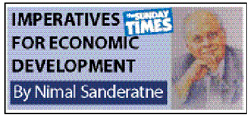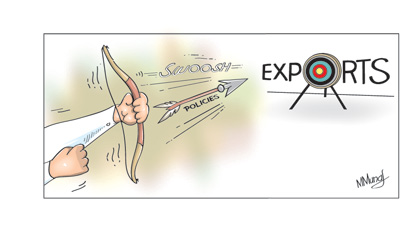Columns
Policies for boosting industrial and agricultural exports
View(s): Sri Lanka’s export growth has been unimpressive. The Institute of Policy Studies, (IPS) in its State of the Economy Report 2014 states: “Despite higher GDP growth in recent years, what appears to be an inexorable decline in the ratio of exports to GDP-falling to a low level of 15.5 per cent in 2013 is a matter of serious concern. Second the declining share of GDP is compounded by loss of market share globally, which is an indicator of the country’s waning competitiveness in international markets”.
Sri Lanka’s export growth has been unimpressive. The Institute of Policy Studies, (IPS) in its State of the Economy Report 2014 states: “Despite higher GDP growth in recent years, what appears to be an inexorable decline in the ratio of exports to GDP-falling to a low level of 15.5 per cent in 2013 is a matter of serious concern. Second the declining share of GDP is compounded by loss of market share globally, which is an indicator of the country’s waning competitiveness in international markets”.
Increasing exports is vital to reduce the trade deficit and strengthen the country’s external finances. The Government is considering revising upwards the current merchandise export target of US$ 20 billion for 2020. A higher target can be achieved only with policy changes conducive to export expansion.
Need policies
Increasing exports is a challenging task that requires comprehensive economic policies such as ensuring healthy macroeconomic fundamentals; economic policies that are conducive to export manufactures; agricultural policies that increase production for exports; foreign direct investment in export industries; friendly relations with trading partners and above all a flexible exchange rate policy that makes exports competitive and imports dearer to promote efficient import substitution.
Micro economic policies that assist exporting firms to be competitive are also important. Private sector exporting firms, too, must improve their organisational and management methods to increase their productivity. Technology, skill development and labour productivity to enhance export competitiveness are vital.
Macroeconomic policies
A competitive exchange rate is one of the foremost macroeconomic conditions needed to encourage exports and reduce the bias in favour of inefficient import substitution created by import protection. The exchange rate must be flexible to enable exports and to reduce imports.
The Government has been reluctant to depreciate the currency as prices of essential imports such as wheat, sugar, milk, fertiliser and oil would increase. In the process it has made many other imports too attractively priced and thereby increased imports and made exports uncompetitive. The balance between incentives to produce exports and produce import substitutes is important. A higher profitability of import substitution could divert production from exports to import substitution that would be inefficient and retard economic growth.
 Many barriers to exporting are within the country itself. A 2010 International Trade Center survey of exporting firms in Sri Lanka found that nearly 70 per cent of the barriers to exporting were within the country. These include overvalued exchanger rate, slow process of approval of exports by various ministries that have to issue certificates of compliance of various types, bureaucratic procedures and bribes to officials to clear goods for exporting.
Many barriers to exporting are within the country itself. A 2010 International Trade Center survey of exporting firms in Sri Lanka found that nearly 70 per cent of the barriers to exporting were within the country. These include overvalued exchanger rate, slow process of approval of exports by various ministries that have to issue certificates of compliance of various types, bureaucratic procedures and bribes to officials to clear goods for exporting.
Microeconomic policies
Microeconomic policies that increase the profitability of export activities and exportable surpluses are also important. The cost structures of exporting firms and their keeping abreast of market trends and requirements are vital in an intensely competitive global market place. In today’s global chains in production of most items, especially electronic items like computers and accessories, television and mobile and IPhones, only the most efficient firms could compete.
Efficient firms in Sri Lanka, especially in garments, have secured recognition in producing upmarket and quality products at competitive prices. Education, skills, training and management efficiencies are critical. While the state plays a vital role in providing and enhancing education and skills to industry, firms themselves must upgrade the skills of their staff.
An export bias in taxation and pricing policies could reduce costs of export products. Many countries assist their manufacturing industries by favourable discriminatory prices on intermediate inputs and energy. This has been lacking in Sri Lanka. For instance, although petroleum prices were reduced, the price of furnace oil that is important for many export industries such as ceramics was not reduced.
Agricultural exports
Agricultural export earnings have not expanded adequately owing to supply constraints. For example rubber that has an international market ceased to be exported in recent years due to supply constraints and its use for domestic manufactures owing to inadequate production. Similarly, coconut exports are minimal as domestic consumption has outpaced production. There is inadequate production of spices, cashew, fruits cardamom, cinnamon and other exportable crops.
Productivity increases and expansion of cultivated area are needed to achieve higher exports in agriculture. A severe constraint is that of the Government not releasing large extents of uncultivated lands for cultivation of coconut, palmyrah, cashew, orchards and vegetables especially in the North and East for cultivation of crops on a large scale for export.
Diversifying markets
Diversifying export markets is considered an important strategy for increasing manufactured exports as most such exports are to Europe and the US. However there is little demand for our exports in those countries as they too produce similar goods. This does not mean that we should not explore selling to them, but increasing exports substantially to them is unrealistic at present.
Export promotion through free trade agreements, diversifying export products and markets and friendly relations with trading partners are important, but appropriate macroeconomic policies conducive to developing competitive export products is the fundamental prerequisite.
Misconception
One misconception in export policies is that our exports should be of high-value-added items. Our exports of manufactures will continue to have large import content as the country’s raw material resource base is narrow. As today’s world, trade is on the basis of comparative advantage in value adding within a supply chain, even a small country like Sri Lanka can participate and be efficient by specialising in one stage of the production process.
Even though exports have high import content, increases in the volume of exports could yield high export incomes. Most exports today are based on imported raw materials, imported components as in the manufacture of computers, mobile and I phones. What is important is to have comparative advantage in a wide range of exportable commodities rather than high value added.
Conclusion
Enhancing export capacity involves incentives for both agricultural and industrial production. The current supply inelasticity of exportable goods must be addressed by a realistic exchange rate that encourages exports and prices imports correctly. Efforts to redirect trade to newer destinations and cautious use of regional free trade agreements could help increase exports but it is more important to ensure the preconditions for increasing exports.


Leave a Reply
Post Comment